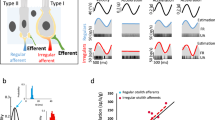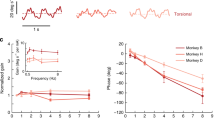Abstract.
Secondary vestibular neurons exhibit a wide variety of responses to a head movement, with the response of each secondary neuron depending upon the particular primary afferents converging onto it. A single head movement is thereby registered in a distributed manner. This paper focuses on implications of afferent convergence to the relative timing of secondary neuron response modulation during rotational movements about a combination of horizontal axes. In particular, the neurons of interest are those that receive input from afferents innervating the vertical semicircular canals, and the movements of interest are those that have a sinusoidal component about one vertical canal axis and a sinusoidal component about another, approximately orthogonal, vertical canal axis. Under these conditions, the present research shows that it is possible for two or more secondary neurons to have a different relative timing of response (i.e., different relative phase of the periodic modulation in firing rate) for different head movements, and for the neurons to switch their order of response for different movements. For particular head movements, those same neurons will respond in phase. From the point of view of the nervous system, the relative timing of neuron responses may tell which movement is taking place, but with certain restrictions as discussed in the present paper. Shown here is that, among those head movements for which the two components of rotation may be at any phase relative to one another and have any relative amplitude, an in-phase response of just two neurons cannot identify a single motion. Two neurons that respond in phase for one motion must respond in phase for an entire range of motions; all motions in that range are thus response-equivalent, in the sense that the pair of neurons cannot distinguish between the two motions. On the other hand, an in-phase response of three neurons can identify a single motion, for certain patterns of primary afferent convergence.
Similar content being viewed by others
Author information
Authors and Affiliations
Additional information
Received: 16 December 1996 / Accepted in revised form: 3 April 1998
Rights and permissions
About this article
Cite this article
Holly, J., McCollum, G. Timing of secondary vestibular neuron responses to a range of rotational head movements. Biol Cybern 79, 39–48 (1998). https://doi.org/10.1007/s004220050456
Issue Date:
DOI: https://doi.org/10.1007/s004220050456




